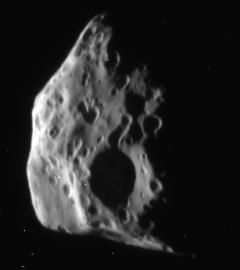Epimetheus Up-Close

Just in on the JPL Raw images page is this view of Epimetheus. This is the best image ever taken of this small inner satellite. Immediately I am reminded of the distant images of Phoebe in terms of the appearance of craters and the distribution and amount of cratering. From the Wikipedia article on Epimetheus, this moon is 119 km across (half the size of Phoebe). It is a very porous body with a density of 0.61 g/cm3 (remember ice has a density of 0.96 g/cm3). Epimetheus is almost co-orbital with the satellite Janus. Every 4 years, they switch orbits, with one orbiting 100 km closer to Saturn than the other. The next swap is scheduled for next February. I saw that Phil Stooke posted a few comments here yesterday so if he comes back today, maybe he can post his comments on these images of Epimetheus.


4 Comments:
OK, Jason, you asked for it! This new view shows the leading side, terminator near 20 degrees, limb about 120 degrees longitude, north up. The two prominent large craters were seen in the best Voyager images (which also, uniquely, showed the F ring shadow on the disk... a phenomenon I'd like to see again, and it might be possible with small moons in slightly inclined orbits very close to the rings...). They are Pollux (near the limb) and Hilairea (near terminator). I once mapped possible lineations on Epimetheus in the lower resolution Voyager images, like Phobos grooves. Are they visible here? The trained and/or biased eye might spot a couple, one inside Pollux and one north of Hilairea. But it's rather subjective! I understood from a status report a couple of weeks ago that we might see some of the other small moons on this orbit. I hope that's true. Well, I suppose I ought to go do some work. The trouble is, there is so much happening in space these days that it's hard to actually do anything but browse!
I don't know if my eye is trained and/or biased, but I'm seeing grooves just where Phil does. Is Pollux the huge dimple at the bottom left of the image - larger than Hilairea?
And would features relating to Hilairea be referred to as Hilaireous?
Sorry.
Some nice color shots have been posted over at the Unmanned Spaceflight forum: http://www.unmannedspaceflight.com/index.php?showtopic=820&view=findpost&p=7768
Certainly looks like a color difference between Pollux and the rest of the satellite.
Just so I am clear on which crater is which when comparing Voyager and Cassini images of Epimetheus. I have made two version of images with both the best Voyager and the best Cassini images of this moon. One without lines connecting Pollux and Hilairea and the other with those lines.
Post a Comment
<< Home